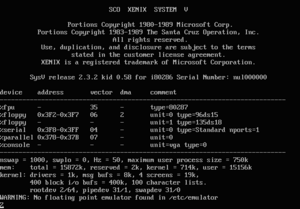
Back زينيكس Arabic Xenix Azerbaijani Xenix BAR Xenix Byelorussian Xenix Catalan زینیکس CKB XENIX Czech Xenix German Microsoft XENIX Spanish Xenix Estonian
 Xenix under Bochs | |
| Developer | Microsoft, SCO, HCR, Logica |
|---|---|
| OS family | Unix (SysV) |
| Working state | Historic |
| Source model | Closed source |
| Initial release | 1980 |
| Latest release | System V Release 2.3.4 / 1991 |
| Platforms | PC/XT, x86, PDP-11, Z8001, 68k |
| Kernel type | Monolithic kernel |
| Default user interface | Command-line interface |
| License | Proprietary |
| Succeeded by | SCO UNIX, OS/2 |
Xenix is a discontinued version of the Unix operating system for various microcomputer platforms, licensed by Microsoft from AT&T Corporation in the late 1970s. The Santa Cruz Operation (SCO) later acquired exclusive rights to the software, and eventually replaced it with SCO UNIX (now known as SCO OpenServer).
In the mid-to-late 1980s, Xenix was the most common Unix variant, measured according to the number of machines on which it was installed.[1][2] Microsoft chairman Bill Gates said at Unix Expo in 1996 that, for a long time, Microsoft had the highest-volume AT&T Unix license.[3]
- ^ Kelleher, Joanne (1986-02-03). "Corporate Unix: A system struggles to earn its stripes". Computerworld. p. 44.
- ^ Leffler, Samuel J.; McKusick, Marshall Kirk; Karels, Michael J.; Quarterman, John S. (October 1989). The Design and Implementation of the 4.3BSD UNIX Operating System. Addison-Wesley. p. 7. ISBN 0-201-06196-1.
- ^ "UNIX Expo — Remarks by Bill Gates". Microsoft. 1996-10-09. Archived from the original on 2001-08-18. Retrieved 2013-09-09.
© MMXXIII Rich X Search. We shall prevail. All rights reserved. Rich X Search